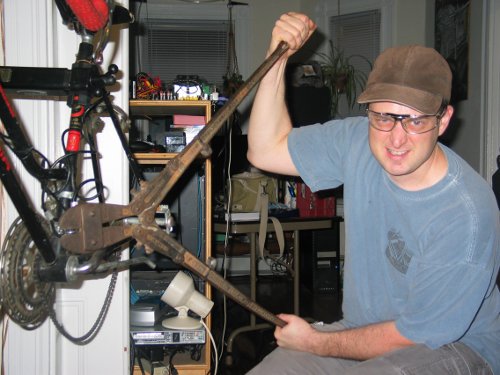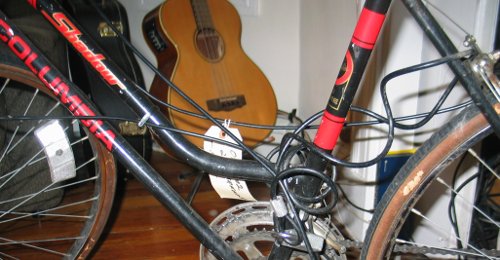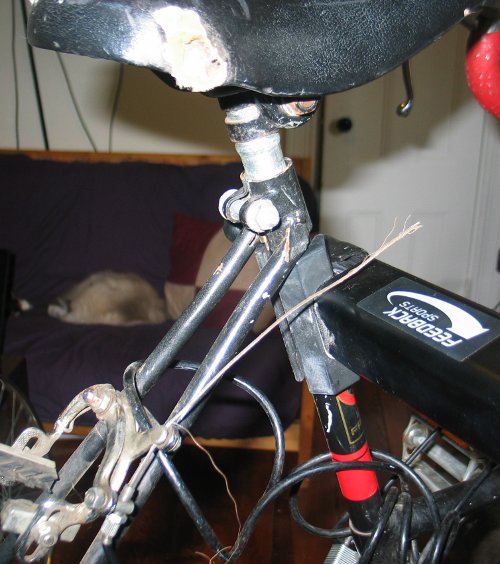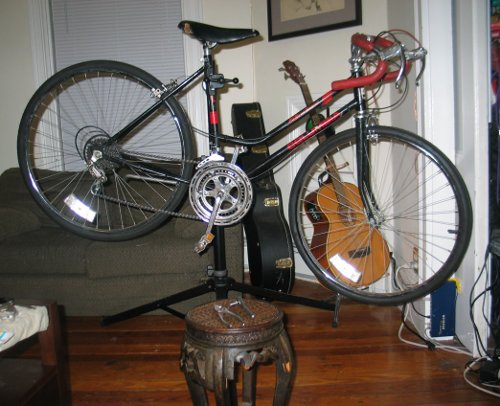Somerville bike auction
y.t. and I went to the Somerville bike auction this past weekend. Her Swobo commuter bicycle frame cracked — a chunk fractured off the seat stay bridge — and the LBS is in the process of trying to get Swobo to honor their warranty and replace the defective frame. In the meantime, we picked this up for almost nothing as a temporary commuter and a bicycle to have on-hand for out-of-town guests:

I spent a few hours on Sunday cleaning it up and learning about its story.
First, a little historical context… I couldn’t find much specific information about this bicycle model on Google. I did learn that it’s likely that less than 5% of all the ten speed bicycle frames built in the 70’s are woman’s frames; the Columbia Shadow was built in the early 70’s in Westfield, MA; and that this particular bicycle doesn’t seem to have much value as an antique although it is definitely uncommon.
More interesting, though, is what this bike’s mechanical condition told me about its previous owner(s).
First of all, this bicycle didn’t have any significant rust. That implies that it was stored indoors and not ridden year-round or in harsh weather conditions. It’s entirely possibly that it didn’t get much use at all for most of its life. The tire sidewalls were disintegrating, but there wasn’t significant wear on the contact areas; the inner tubes were clean and intact and held air.

A cable lock and Masterlock were attached to this bike. The lock was locked to the frame and not to the bike, so it was possibly abandoned or stolen from an indoor location and recovered by the City of Somerville. I considering making a bump key to open the lock, but didn’t have an old Masterlock key hanging around; I ended borrowing bolt cutters and using brute force to remove the lock.

The crankset and the headset were loose. I disassembled both and found that the oil inside had dried into an almost glue-like consistency. This same “glue” permeates the rear derailleur, which I haven’t cleaned yet. The locknut that held the crank in place was slightly chewed, which implies that it was previously dissassembled. Whatever lubricant was used was probably not a good choice for this application, since it eventually ended up inhibiting the free movement of all of the bearings it was applied to.
There were several creative repairs made to this bicycle. Scotch tape remnants had been applied to some minor tears in the seat’s fabric. Scotch tape was also used to hold the rear shifter levers in position on the handlebars. The handlebars had been adjusted to sit at an odd upward angle, probably in an attempt to have a more upright riding position. All of the brake levers were loosely attached to the handlebars; it only took a few minutes to reposition them and tighten them back into position.
The shift levers had been reinstalled backwards and upside down. The shift cables were significantly worn, had a few missing ferrules, and were mostly not routed along the frame. I suspect that the shift cables were cut short as the ends wore down, and the lever position was changed so that the shortened cables could still reach the derailleurs.

The brake cables were in better shape. The front brake cable looked original and is still in working order, although it was missing a ferrule. The rear brake cable wasn’t thoroughly secured to the frame; the cable extended several inches past the brakes and probably would have occasionally stabbed anyone riding this bike. None of the cable ends had crimps.
One of the strands from the rear brake cable was also used to hold another cable in place. Necessity is the mother of invention:

The front brakes were also missing pads; I’m guessing they were sacrificed for use on the rear. This suggests that someone had the common misconception that the back wheel is a more effective braking wheel than the front.
When all this is put together, this bicycle probably had one previous owner who probably:
– rode recreationally in good weather conditions
– rode regularly enough to wear down some components
– stored the bicycle indoors
– did their own repairs, inexpertly
– eventually stopped riding in part because the bicycle was unpleasant to ride after all these odd repairs.
Cleaning, re-lubricating, replacing and routing cables and housing, replacing the tires, and readjusting all of the components back into normal tolerances have made a world of difference:

 Comments(4)
Comments(4)